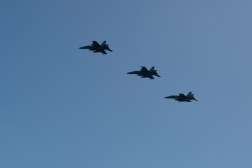Navy adding funds to increase range of next-generation jammer capability

The Navy has added funding in its budget plans for a critical airborne electronic attack capability that’s expected to provide increased range and address specific gaps.
The Navy is requesting an increase of $32.5 million in research and development funding for the Next Generation Jammer Mid-Band Extended (NGJ-MBX) in fiscal 2024.
The next-gen system, which is the replacement for the decades old ALQ-99, will be mounted on the EA-18G Growler aircraft.
The program was initially broken up into three separate jamming pods covering various ends of the electromagnetic spectrum based upon criticality of current and emerging threats: Mid-Band (which was awarded to Raytheon in 2016), Low-Band (which is still in source selection) and High-Band (for which there hasn’t been any line item in Navy budgets since at least fiscal 2020).
The pods are expected to be significantly more powerful than the ALQ-99, with extended range and the ability to jam multiple targets simultaneously. With the increase in sophistication and range of adversaries’ military systems — especially across the Pacific — such a jamming capability could be critically important for the U.S. military in future conflicts.
According to a Navy spokesperson, the MBX is an extension of the current Mid-Band pod, dubbed AN/ALQ-249 in Navy parlance. The effort will involve certain upgrades to both software and hardware components for extended frequency coverage and will be an engineering change to the existing pod.
The MBX “involves an Engineering Change Proposal (ECP) to the current NGJ-MB system that will extend the upper frequency coverage limit to counter modern and adaptive threats,” according to budget documents. “This modification will improve frequency range of the NGJ-MB system and enhance the survivability of the platform and protected entities against emerging threats.”
Design and development for MBX is slated to begin in fiscal 2024.
Part of the motivation for pursuing the MBX is the identification of a gap in coverage within the spectrum.
In the fiscal 2021 annual defense policy bill, Congress expressed some level of concern regarding the NGJ program. In the final bill that became law, Congress required a report on the strategy of the NGJ to ensure full spectrum electromagnetic superiority.
In what is known as an item of special interest in a House Armed Services Committee chairman’s mark, which typically sets the stage for future legislation or documents how lawmakers feels about a certain topic, the committee raised concerns regarding the lack of funding for the High-Band portion of the program.
“The committee supports the ongoing development of the Department of the Navy’s Next Generation Jammer mid and low-band capabilities but notes that the Navy has yet to begin to address the high band threat,” a provision in the fiscal 2022 policy bill mark stated. “The committee is aware that the Navy’s airborne electronic attack community views a high band capability as a top modernization priority and that the existing tactical jammer on the EA-18 Growler is not equipped to meet evolving threats. The committee concurs with this assessment and recognizes the need for an upgraded high band jamming capability for the Navy’s EA-18 Growler.”
The Airborne Electronic Attack Systems Program Office submitted a report to Congress in early 2022, a spokesperson said, to address options for a High-Band solution. As a result of the report, the Navy decided to pursue a frequency extension of the Mid-Band as the quickest way to address near-term threats.
The spokesperson added that the High-Band capability still remains unfunded.
The Navy is requesting a 2.5% increase for Mid-Band procurement for fiscal 2024 from projections in the previous budget plan. Fiscal 2023 budget documents projected a $415.5 million spend for fiscal 2024, however, the latest budget request is asking for $426.3 million.
The increase reflects updated cost estimates for the Mid-Band pod shipset based on low-rate initial production negotiations, and due in part to inflation, the Navy spokesperson said.
The total R&D request for Mid-Band is $40.4 million.
There is not much the Navy is saying regarding the Low-Band program given it is still in source selection.
The Low-Band is coming off a lengthy litigation battle, which involved a stop work order issued by the Government Accountability Office that effectively rendered the program stalled.
L3Harris, which won the bid for low-band over Northrop Grumman, filed suit in September 2021 in the Court of Federal Claims protesting a decision by the GAO that required the Navy to potentially reopen proposals for the effort.
The GAO sided with Northrop, which alleged the Navy failed to consider the potential conflict of interest of a former Navy employee that developed specifications for the program while simultaneously negotiating for employment with L3Harris during the solicitation.
Complicating matters further, the Navy during the Low-Band bid process awarded two companies under a demonstration of technologies and planned to choose the best solution for the ultimate award. One company was Northrop Grumman — which teamed with Harris — and the other was L3 (at that time, L3 and Harris had not yet merged).
The Navy, along with the companies, came to an agreement and is reopening bids for the Low-Band program.
There is no procurement request for the Low-Band in fiscal 2024 or across the future years defense program, however, the cost to complete is $2.7 billion as compared to a $2.4 billion total spend in budget documents from fiscal 2023. A Navy spokesperson declined to comment given the ongoing source selection.
The Navy is requesting $250.5 million for R&D for the Low-Band pod, a decrease of $102.3 million from fiscal 2023 that is due to the contract award delay, according to budget documents.






